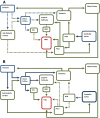The role of the trigeminal sensory nuclear complex in the pathophysiology of craniocervical dystonia
- PMID: 24259561
- PMCID: PMC6618800
- DOI: 10.1523/JNEUROSCI.3544-13.2013
The role of the trigeminal sensory nuclear complex in the pathophysiology of craniocervical dystonia
Abstract
Isolated focal dystonia is a neurological disorder that manifests as repetitive involuntary spasms and/or aberrant postures of the affected body part. Craniocervical dystonia involves muscles of the eye, jaw, larynx, or neck. The pathophysiology is unclear, and effective therapies are limited. One mechanism for increased muscle activity in craniocervical dystonia is loss of inhibition involving the trigeminal sensory nuclear complex (TSNC). The TSNC is tightly integrated into functionally connected regions subserving sensorimotor control of the neck and face. It mediates both excitatory and inhibitory reflexes of the jaw, face, and neck. These reflexes are often aberrant in craniocervical dystonia, leading to our hypothesis that the TSNC may play a central role in these particular focal dystonias. In this review, we present a hypothetical extended brain network model that includes the TSNC in describing the pathophysiology of craniocervical dystonia. Our model suggests the TSNC may become hyperexcitable due to loss of tonic inhibition by functionally connected motor nuclei such as the motor cortex, basal ganglia, and cerebellum. Disordered sensory input from trigeminal nerve afferents, such as aberrant feedback from dystonic muscles, may continue to potentiate brainstem circuits subserving craniocervical muscle control. We suggest that potentiation of the TSNC may also contribute to disordered sensorimotor control of face and neck muscles via ascending and cortical descending projections. Better understanding of the role of the TSNC within the extended neural network contributing to the pathophysiology of craniocervical dystonia may facilitate the development of new therapies such as noninvasive brain stimulation.
Figures



References
-
- Aldes LD, Boone TB. Organization of projections from the principal sensory trigeminal nucleus to the hypoglossal nucleus in the rat: an experimental light and electron microscopic study with axonal tracer techniques. Exp Brain Res. 1985;59:16–29. - PubMed
MeSH terms
LinkOut - more resources
Full Text Sources
Other Literature Sources
